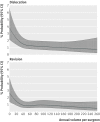Relation between surgeon volume and risk of complications after total hip arthroplasty: propensity score matched cohort study
- PMID: 24859902
- PMCID: PMC4032026
- DOI: 10.1136/bmj.g3284
Relation between surgeon volume and risk of complications after total hip arthroplasty: propensity score matched cohort study
Abstract
Objectives: To identify a cut point in annual surgeon volume associated with increased risk of complications after primary elective total hip arthroplasty and to quantify any risk identified.
Design: Propensity score matched cohort study.
Setting: Ontario, Canada.
Participants: 37,881 people who received their first primary total hip arthroplasty during 2002-09 and were followed for at least two years after their surgery.
Main outcome measure: The rates of various surgical complications within 90 days (venous thromboembolism, death) and within two years (infection, dislocation, periprosthetic fracture, revision) of surgery.
Results: Multivariate splines were developed to visualize the relation between surgeon volume and the risk for various complications. A threshold of 35 cases a year was identified, under which there was an increased risk of dislocation and revision. 6716 patients whose total hip arthroplasty was carried out by surgeons who had done ≤ 35 such procedure in the previous year were successfully matched to patients whose surgeon had carried out more than 35 procedures. Patients in the former group had higher rates of dislocation (1.9% v 1.3%, P=0.006; NNH 172) and revision (1.5% v 1.0%, P=0.03; NNH 204).
Conclusions: In a cohort of first time recipients of total hip arthroplasty, patients whose operation was carried by surgeons who had performed 35 or fewer such procedures in the year before the index procedure were at increased risk for dislocation and early revision. Surgeons should consider performing 35 cases or more a year to minimize the risk for complications. Furthermore, the methods used to visualize the relationship between surgeon volume and the occurrence of complications can be easily applied in any jurisdiction, to help inform and optimize local healthcare delivery.
© Ravi et al 2014.
Conflict of interest statement
Competing interests: All authors have completed the ICMJE uniform disclosure form at
Ethical approval: Not required.
Figures




Comment in
-
Surgeon volume and early complications after primary total hip arthroplasty.BMJ. 2014 May 23;348:g3433. doi: 10.1136/bmj.g3433. BMJ. 2014. PMID: 24859903 No abstract available.
-
Patient injuries in primary total hip replacement.Acta Orthop. 2016 Jun;87(3):209-17. doi: 10.3109/17453674.2015.1135662. Epub 2016 Jan 25. Acta Orthop. 2016. PMID: 26808350 Free PMC article.
References
-
- Lavernia CJ, Guzman JF. Relationship of surgical volume to short-term mortality, morbidity, and hospital charges in arthroplasty. J Arthroplasty 1995;10:133-40. - PubMed
-
- Katz JN, Phillips CB, Baron JA, Fossel AH, Mahomed NN, Barrett J, et al. Association of hospital and surgeon volume of total hip replacement with functional status and satisfaction three years following surgery. Arthritis Rheum 2003;48:560-8. - PubMed
-
- Losina E, Barrett J, Mahomed NN, Baron JA, Katz JN. Early failures of total hip replacement: effect of surgeon volume. Arthritis Rheum 2004;50:1338-43. - PubMed
-
- Katz JN, Losina E, Barrett J, Phillips CB, Mahomed NN, Lew RA, et al. Association between hospital and surgeon procedure volume and outcomes of total hip replacement in the United States medicare population. J Bone Joint Surg Am 2001;83-A:1622-9. - PubMed
Publication types
MeSH terms
Grants and funding
LinkOut - more resources
Full Text Sources
Other Literature Sources
Medical
